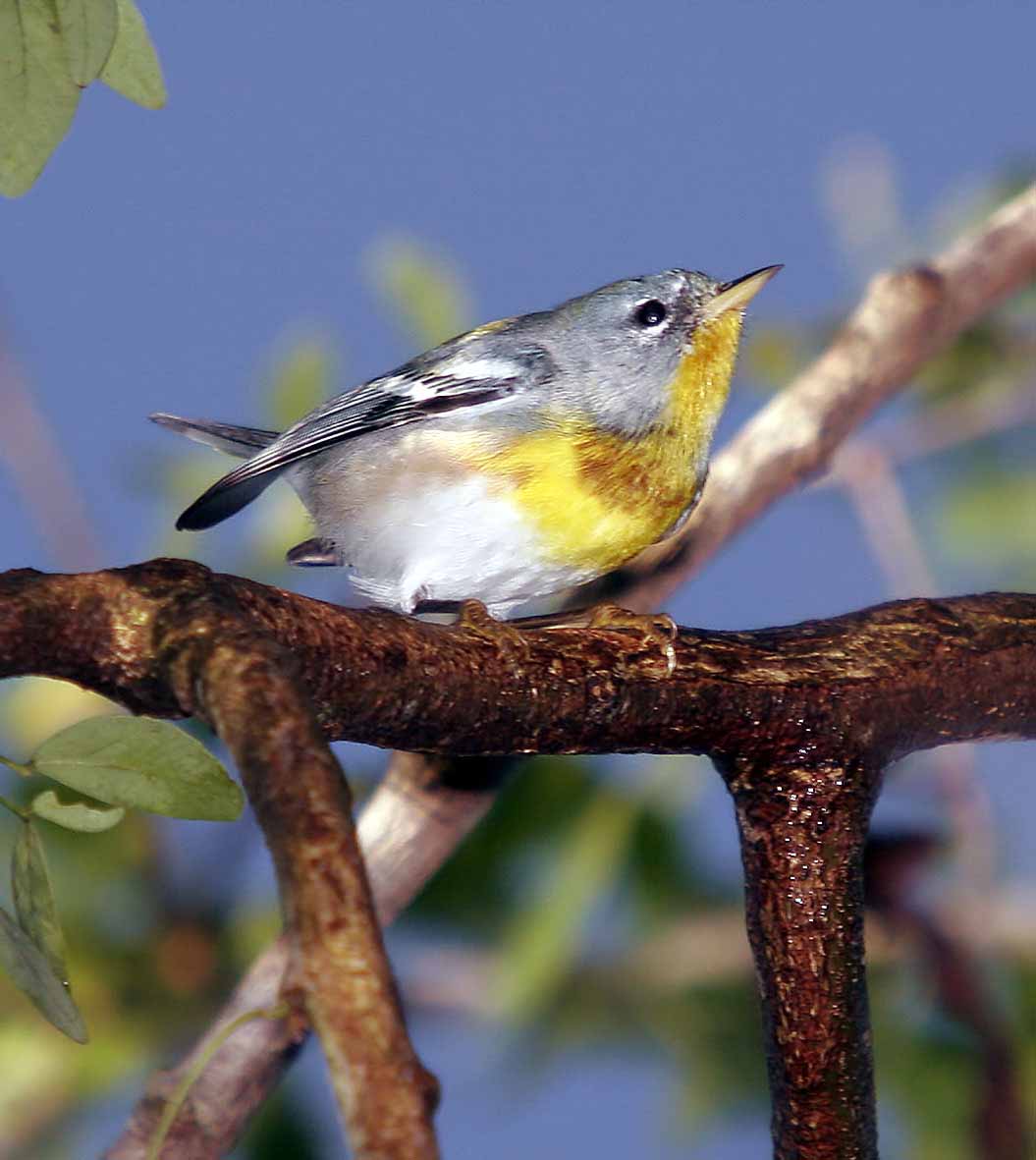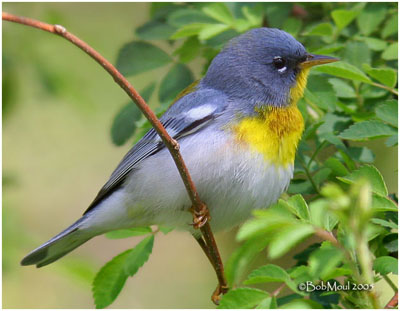
Northern Parula
Setophaga americana
Passeriforme Order - Parulidae Family
BIOMETRICS:
Length: 11-12 cm; Wingspan: 16-18 cm; Weight: 5-11 g
LONGEVITY: 4 years
DESCRIPTION:

Northern Parula is a small warbler with bluish-grey upperparts, two broad white wing bars and a bright yellow throat and upper breast, latter contrasting with white lower underparts in all plumages.
A closer view may reveal broken white eye-ring, olive-bronze mantle, bluish-grey sides of breast and white patches on outer tail, noticeably short.
Male shows a narrow orange-rufous breast band and often some orange-rufous patches on upper flanks. It has also black lores and eye line.
It has a thin and pointed bill, with dark upper mandible, and orange yellow lower mandible. Legs and feet are yellow.
Sexes are similar, but female is duller and usually lacks breast bands.
Immature is similar to female, but it has more green on upperparts.
FLIGHT:
Northern Parula has a rapid and agile flight, hovering among foliage to feed.
REPRODUCTION:
Northern Parula’s nest is built inside a mass of hanging beard lichen (“old man’s beard”, the lichen Usnea), usually with no other lining than that provided by the plant itself, but the bowl is sometimes lined with hair, fine grasses, pine needles or plant down. The nest is carefully woven into the base of a high clump of Spanish moss (Tillandsia usnoides). It is built at 6 to 100 feet above the ground. Trees are chosen for nest site if they are well decorated with this lichen. (“Old man’s beard” grows hanging from tree branches, resembling grey or greenish hair).
Female lays 3 to 7 white eggs, speckled with cinnamon around the larger end. Incubation lasts about 12 to 14 days by female alone. Male feeds the female while she incubates the eggs. Youngs fledge after 10 days, still unable to fly. Female does most of the feeding while the male sings.
This species may produce two broods per year in the South, but only one in the North, between March/April and late August.
DIET:
Northern Parula feeds mostly on insects, caterpillars, ants, bees, wasps, and spiders. Vegetable matter does not appear to be an important component of its diet.
PROTECTION / THREATS / STATUS:
Overall species population appears to be stable, varying from region to region. Declines have occurred in the Mississippi Valley and southern coastal plains, whereas northern and Appalachian populations have increased.
Knowledge of precise habitat requirements and vulnerability to forest fragmentation will be important for sustaining future populations.
Fr: Paruline à collier
All : Meisenwaldsänger
Esp : Párula de Pecho Dorado
Ital: Parula americana
Nd: Noordelijke Parula
Sd: Messångare
Photograph by Alfredo Colón
Puerto Rico Wildlife
Photograph by Bob Moul
Nature Photography
Text by Nicole Bouglouan
Sources:
THE HANDBOOK OF BIRD IDENTIFICATION FOR EUROPE AND THE WESTERN PALEARCTIC by Mark Beaman, Steve Madge - C.Helm - ISBN: 0713639601
FIELD GUIDE TO THE BIRDS OF NORTH AMERICA – National Geographic Society - ISBN: 0792274512
All About Birds (Cornell Lab of Ornithology)
What Bird-The ultimate Bird Guide (Mitchell Waite)
Wikipedia (Wikipedia, The Free Encyclopedia)
Birds of Nova Scotia (Robie Tufts)
Bird Web (Seattle Audubon Society)
South Dakota Birds and Birding (Terry L. Sohl)
VOICE: SOUNDS BY XENO-CANTO
Northern Parula’s call is a sharp, sudden “zip” or “chip”. Song is a fast, ascending, buzzing, metallic trill that ends abruptly with a “zip”.
HABITAT:
Northern Parula breeds in all kinds of woodland, especially near water. On migration, we can see it also in bushy areas and thickets.
They breed mostly in coniferous forests in the North, but prefer deciduous woodlands in the South.
RANGE:
Northern Parula breeds from N Ontario to Nova Scotia, and N Minnesota to N New York and S New Hampshire, and also from S Iowa to S New York, southward to E Texas and Florida.
It winters in S Mexico to Honduras and in the Caribbean. Some populations winter in very southern Florida.
BEHAVIOUR:
Northern Parula is an active little warbler, constantly on the move, flicking wings and dropping to lower perches, usually in middle to upper canopy of trees.
Northern Parula forages actively to feed on insects. Most commonly gleans tips of foliage, small twigs and branches high in the canopy. Occasionally, it hovers or hangs upside down on foliage, and sallies out for aerial insects.
Physical conflicts can take the form of tightly, whirling aerial “dogfights” and chases, accompanied by vigorous chipping.
